Carbon Nano-Onions–Polyvinyl Alcohol Nanocomposite for Resistive Monitoring of Relative Humidity
Abstract
Highlights
- A novel chemiresistive sensor utilizing (carbon nano-onions) CNOs and (polyvinyl alcohol) PVA sensing layers demonstrates effective relative humidity (RH) detection.
- The sensitivity is highly reproducible across multiple sensors for the sensor made with CNOs–PVA (1:1, w/w) sensing layers.
- The developed RH sensor architecture is both sustainable and metal-free, employing nanocarbon materials.
- It offers distinct sensitivity across two humidity domains, making it a promising solution for eco-friendly and precise humidity sensing applications.
Abstract
1. Introduction
2. Materials and Methods
2.1. Materials
2.2. Synthesis of the Nanocarbon Composite Sensing Layer and Experimental Setup
3. Results
3.1. Surface Topography
3.2. Raman Spectroscopy
3.3. X-Ray Diffraction Results
3.4. Atomic Force Microscopy Measurements
3.5. RH Monitoring Capability
4. Discussion
5. Conclusions
Author Contributions
Funding
Institutional Review Board Statement
Informed Consent Statement
Data Availability Statement
Conflicts of Interest
Abbreviations
| CNH | Carbon nanohorn |
| CNHox | Oxidized carbon nanohorn |
| CNO | Carbon nano-onion |
| GO | Graphene oxide |
| IDT | Interdigitated |
| MWCNT | Multi-walled carbon nanotube |
| MS | Manufactured sensor |
| PVA | Polyvinyl alcohol |
| PVP | Polyvinyl pyrrolidone |
| PMMA | Poly(methyl methacrylate) |
| REF | Reference sensor |
| RGO | Reduced graphene oxide |
| RH | Relative humidity |
| SAW | Surface acoustic wave |
| SWCNT | Single-walled carbon nanotube |
References
- Alam, N.; Abid; Islam, S.S. Advancements in trace and low humidity sensors technologies using nanomaterials: A review. ACS Appl. Nano Mater. 2024, 7, 13836–13864. [Google Scholar] [CrossRef]
- Li, J.; Fang, Z.; Wei, D.; Liu, Y. Flexible pressure, humidity, and temperature sensors for human health monitoring. Adv. Healthc. Mater. 2024, 13, 2401532. [Google Scholar] [CrossRef]
- Humidity Sensor Market Size, Share & Trends Analysis Report by Type (Absolute Humidity Sensor, Relative Humidity Sensor), by End Use (Automotive, Industrial), by Region, and Segment Forecasts, 2025–2030, Grand View Research, Market Analysis Report. Available online: https://www.grandviewresearch.com/industry-analysis/humidity-sensor-market (accessed on 25 March 2025).
- Arman Kuzubasoglu, B. Recent studies on the humidity sensor: A mini review. ACS Appl. Electron. Mater. 2022, 4, 4797–4807. [Google Scholar] [CrossRef]
- Ku, C.A.; Chung, C.K. Advances in humidity nanosensors and their application. Sensors 2023, 23, 2328. [Google Scholar] [CrossRef] [PubMed]
- Korotcenkov, G. Based Humidity Sensors as Promising Flexible Devices: State of the Art: Part 1. General Consideration. Nanomaterials 2023, 13, 1110. [Google Scholar] [CrossRef] [PubMed]
- Steele, J.J.; Taschuk, M.T.; Brett, M.J. Nanostructured metal oxide thin films for humidity sensors. IEEE Sens. J. 2008, 8, 1422–1429. [Google Scholar] [CrossRef]
- Kumar, A.; Gupta, G.; Bapna, K.; Shivagan, D.D. Semiconductor-metal-oxide-based nanocomposites for humidity sensing applications. Mater. Res. Bull. 2023, 158, 112053. [Google Scholar] [CrossRef]
- Czajkowski, M.; Guzik, M. Humidity-sensitive luminescent dye-doped polyelectrolyte films: Fabrication, characterization, and potential application as colorimetric moisture sensor. Dye. Pigment. 2024, 231, 112390. [Google Scholar]
- Dai, J.; Zhao, H.; Lin, X.; Liu, S.; Liu, Y.; Liu, X.; Zhang, T. Ultrafast response polyelectrolyte humidity sensor for respiration monitoring. ACS Appl. Mater. Interfaces 2019, 11, 6483–6490. [Google Scholar] [CrossRef]
- Cho, M.Y.; Kim, S.; Kim, I.S.; Kim, E.S.; Wang, Z.J.; Kim, N.Y.; Kim, S.W.; Oh, J.M. Perovskite-induced ultrasensitive and highly stable humidity sensor systems prepared by aerosol deposition at room temperature. Adv. Funct. Mater. 2020, 30, 1907449. [Google Scholar] [CrossRef]
- Pi, M.; Wu, D.; Wang, J.; Chen, K.; He, J.; Yang, J.; Zhang, D.; Chen, S.; Tang, X. Real-time and ultrasensitive humidity sensor based on lead-free Cs2SnCl6 perovskites. Sens. Actuators B Chem. 2022, 354, 131084. [Google Scholar] [CrossRef]
- Rivadeneyra, A.; Salmeron, J.F.; Murru, F.; Lapresta-Fernández, A.; Rodríguez, N.; Capitan-Vallvey, L.F.; Morales, D.P.; Salinas-Castillo, A. Carbon dots as sensing layer for printed humidity and temperature sensors. Nanomaterials 2020, 10, 2446. [Google Scholar] [CrossRef] [PubMed]
- Duan, Z.; Yuan, Z.; Jiang, Y.; Yuan, L.; Tai, H. Amorphous carbon material of daily carbon ink: Emerging applications in pressure, strain, and humidity sensors. J. Mater. Chem. C 2023, 11, 5585–5600. [Google Scholar] [CrossRef]
- Epeloa, J.; Repetto, C.E.; Gómez, B.J.; Nachez, L.; Dobry, A. Resistivity humidity sensors based on hydrogenated amorphous carbon films. Mater. Res. Express 2018, 6, 025604. [Google Scholar] [CrossRef]
- Meng, J.; Liu, T.; Meng, C.; Lu, Z.; Li, J. Porous carbon nanofibres with humidity sensing potential. Microporous Mesoporous Mater. 2023, 359, 112663. [Google Scholar] [CrossRef]
- Yao, Y.; Chen, X.; Ma, W.; Ling, W. Quartz crystal microbalance humidity sensors based on nanodiamond sensing films. IEEE Trans. Nanotechnol. 2014, 13, 386–393. [Google Scholar] [CrossRef]
- Wu, X.; Wu, H.; Jin, F.; Ge, H.L.; Gao, F.; Wu, Q.; Wang, S.; Wang, Y.; Yang, H. Facile preparation of fullerenol-based humidity sensor with highly fast response. Fuller. Nanotub. Carbon Nanostruct. 2023, 31, 1132–1136. [Google Scholar] [CrossRef]
- Liang, R.; Luo, A.; Zhang, Z.; Li, Z.; Han, C.; Wu, W. Research progress of graphene-based flexible humidity sensor. Sensors 2020, 20, 5601. [Google Scholar] [CrossRef]
- Borini, S.; White, R.; Wei, D.; Astley, M.; Haque, S.; Spigone, E.; Harris, N.; Kivioja, J.; Ryhänen, T. Ultrafast graphene oxide humidity sensors. ACS Nano 2013, 7, 11166–11173. [Google Scholar] [CrossRef]
- Ghosh, R.; Midya, A.; Santra, S.; Ray, S.K.; Guha, P.K. Humidity sensing by chemically reduced graphene oxide. In Physics of Semiconductor Devices: 17th International Workshop on the Physics of Semiconductor Devices 2013; Springer International Publishing: Berlin/Heidelberg, Germany, 2014; pp. 699–701. [Google Scholar]
- Serban, B.C.; Cobianu, C.; Buiu, O.; Bumbac, M.; Dumbravescu, N.; Avramescu, V.; Nicolescu, C.M.; Brezeanu, M.; Radulescu, C.; Comanescu, F.; et al. Quaternary Oxidized Carbon Nanohorns—Based Nanohybrid as Sensing Coating for Room Temperature Resistive Humidity Monitoring. Coatings 2021, 11, 530. [Google Scholar] [CrossRef]
- Kausar, A. Prevailing research trends in carbon nanohorn and polymer-based hybrids. Polym-Plast Technol. 2018, 57, 118–132. [Google Scholar] [CrossRef]
- Serban, B.C.; Cobianu, C.; Buiu, O.; Bumbac, M.; Dumbravescu, N.; Avramescu, V.; Nicolescu, C.M.; Brezeanu, M.; Radulescu, C.; Comanescu, F.C.; et al. Quaternary Holey Carbon Nanohorns/SnO2/ZnO/PVP Nano-Hybrid as Sensing Element for Resistive-Type Humidity Sensor. Coatings 2021, 11, 1307. [Google Scholar] [CrossRef]
- Almeida Gonzalez, H.D.; Hernandez Ojeda, J.; Corcho-Valdés, A.L.; Padron-Ramirez, I.; Perez Cruz, M.; Iriarte-Mesa, C.; Desdin-Garcia, L.F.; Gobbo, P.; Antuch, M. The Promise of Carbon Nano-Onions: Preparation, Characterization and Their Application in Electrochemical Sensing. Anal. Sens. 2025, 5, e202400035. [Google Scholar] [CrossRef]
- Memon, M.M.; Hongyuan, Y.; Pan, S.; Wang, T.; Zhang, W. Surface acoustic wave humidity sensor based on hydrophobic polymer film. J. Electron. Mater. 2022, 51, 5627–5634. [Google Scholar] [CrossRef]
- Irawati, N.; Abdullah, T.N.R.; Rahman, H.A.; Ahmad, H.; Harun, S.W. PMMA microfiber loop resonator for humidity sensor. Sens. Actuators A Phys. 2017, 260, 112–116. [Google Scholar] [CrossRef]
- Xu, W.; Huang, W.B.; Huang, X.G.; Yu, C.Y. A simple fiber-optic humidity sensor based on extrinsic Fabry–Perot cavity constructed by cellulose acetate butyrate film. Opt. Fiber Technol. 2013, 19, 583–586. [Google Scholar] [CrossRef]
- Sears, W.M. The effect of humidity on the electrical conductivity of mesoporous polythiophene. Sens. Actuators B Chem. 2008, 130, 661–667. [Google Scholar] [CrossRef]
- Serban, B.; Bercu, M.; Voicu, S.; Mihaila, M.; Nechifor, G.; Cobianu, C. Calixarene-doped polyaniline for applications in sensing. In Proceedings of the 2006 International Semiconductor Conference, Sinaia, Romania, 27–29 September 2006; IEEE: New York, NY, USA, 2006; Volume 2, pp. 257–260. [Google Scholar]
- Dai, J.; Zhao, H.; Lin, X.; Liu, S.; Fei, T.; Zhang, T. Design strategy for ultrafast-response humidity sensors based on gel polymer electrolytes and application for detecting respiration. Sens. Actuators B Chem. 2020, 304, 127270. [Google Scholar] [CrossRef]
- Yang, J.; Guan, C.; Yu, Z.; Yang, M.; Shi, J.; Wang, P.; Yang, J.; Yuan, L. High sensitivity humidity sensor based on gelatin coated side-polished in-fiber directional coupler. Sens. Actuators B Chem. 2020, 305, 127555. [Google Scholar] [CrossRef]
- Fei, T.; Zhao, H.; Jiang, K.; Zhou, X.; Zhang, T. Polymeric humidity sensors with nonlinear response: Properties and mechanism investigation. J. Appl. Polym. Sci. 2013, 130, 2056–2061. [Google Scholar] [CrossRef]
- Soomro, A.M.; Jabbar, F.; Ali, M.; Lee, J.W.; Mun, S.W.; Choi, K.H. All-range flexible and biocompatible humidity sensor based on poly lactic glycolic acid (PLGA) and its application in human breathing for wearable health monitoring. J. Mater. Sci. Mater. Electron 2019, 30, 9455–9465. [Google Scholar] [CrossRef]
- Chen, L.H.; Li, T.; Chan, C.C.; Menon, R.; Balamurali, P.; Shaillender, M.; Neu, B.; Ang, X.M.; Zu, P.; Wong, W.C.; et al. Chitosan based fiber-optic Fabry–Perot humidity sensor. Sens. Actuators B Chem. 2012, 169, 167–172. [Google Scholar] [CrossRef]
- Akita, S.; Sasaki, H.; Watanabe, K.; Seki, A. A humidity sensor based on a hetero-core optical fiber. Sens. Actuators B Chem. 2010, 147, 385–391. [Google Scholar] [CrossRef]
- Qian, J.; Tan, R.; Feng, M.; Shen, W.; Lv, D.; Song, W. Humidity Sensing Using Polymers: A Critical Review of Current Technologies and Emerging Trends. Chemosensors 2024, 12, 230. [Google Scholar] [CrossRef]
- Mahapure, P.D.; Gangal, S.A.; Aiyer, R.C.; Gosavi, S.W. Combination of polymeric substrates and metal-polymer nanocomposites for optical humidity sensors. J. Appl. Polym. Sci. 2019, 136, 47035. [Google Scholar] [CrossRef]
- Tang, M.; Liu, X.; Zhang, D.; Zhang, H.; Xi, G. Ultra-sensitive humidity QCM sensor based on sodium alginate/polyacrylonitrile composite film for contactless Morse code communication. Sens. Actuators B Chem. 2024, 407, 135429. [Google Scholar] [CrossRef]
- Feng, D.; Zheng, H.; Sun, H.; Li, J.; Xi, J.; Deng, L.; Guo, Y.; Jiang, B.; Zhao, J. SnO2/polyvinyl alcohol nanofibers wrapped tilted fiber grating for high-sensitive humidity sensing and fast human breath monitoring. Sens. Actuators B Chem. 2023, 388, 133807. [Google Scholar] [CrossRef]
- Seo, Y.K.; Chitale, S.K.; Lee, U.; Patil, P.; Chang, J.S.; Hwang, Y.K. Formation of polyaniline-MOF nanocomposites using nano-sized Fe (III)-MOF for humidity sensing application. J. Nanosci. Nanotechnol. 2019, 19, 8157–8162. [Google Scholar] [CrossRef]
- Zu, Y.; Duan, Z.; Yuan, Z.; Jiang, Y.; Tai, H. Electrospun nanofiber-based humidity sensors: Materials, devices, and emerging applications. J. Mater. Chem. A 2024, 12, 27157–27179. [Google Scholar] [CrossRef]
- Tulliani, J.M.; Inserra, B.; Ziegler, D. Carbon-based materials for humidity sensing: A short review. Micromachines 2019, 10, 232. [Google Scholar] [CrossRef]
- Cai, C.; Zhao, W.; Yang, J.; Zhang, L. Sensitive and flexible humidity sensor based on sodium hyaluronate/MWCNTs composite film. Cellulose 2021, 28, 6361–6371. [Google Scholar] [CrossRef]
- Zhang, R.; Huang, J.; Guo, Z. Functionalized paper with intelligent response to humidity. Colloids Surf. A Physicochem. Eng. Asp. 2022, 633, 127844. [Google Scholar] [CrossRef]
- Zhang, M.; Duan, Z.; Jiang, Y.; Tai, H. Electrochemical humidity sensor based on NaCl/OH-MWCNTs electrolyte for breathing frequency detection. In Proceedings of the Fifth International Conference on Mechanical Engineering and Materials (ICMEM 2024), Nanchang, China, 15–16 November 2024; Volume 13547, pp. 79–83. [Google Scholar]
- Rahman, S.A.; Khan, S.A.; Rehman, M.M.; Kim, W.Y. Highly sensitive and stable humidity sensor based on the bi-layered PVA/graphene flower composite film. Nanomaterials 2022, 12, 1026. [Google Scholar] [CrossRef] [PubMed]
- Bhangare, B.; Jagtap, S.; Ramgir, N.; Waichal, R.; Muthe, K.P.; Gupta, S.K.; Gadkari, S.C.; Aswal, D.K.; Gosavi, S. Evaluation of humidity sensor based on PVP-RGO nanocomposites. IEEE Sens. J. 2018, 18, 9097–9104. [Google Scholar] [CrossRef]
- Wang, Y.; Shen, C.; Lou, W.; Shentu, F. Fiber optic humidity sensor based on the graphene oxide/PVA composite film. Opt. Commun. 2016, 372, 229–234. [Google Scholar] [CrossRef]
- Kafy, A.; Akther, A.; Shishir, M.I.; Kim, H.C.; Yun, Y.; Kim, J. Cellulose nanocrystal/graphene oxide composite film as humidity sensor. Sens. Actuators A Phys. 2016, 247, 221–226. [Google Scholar] [CrossRef]
- Yoo, K.P.; Lima, L.-T.; Min, N.-K.; Lee, M.J.; Lee, C.J.; Park, C.-W. Novel resistive-type humidity sensor based on multiwall carbon nanotube/polyimide composite films. Sens. Actuators B Chem. 2010, 145, 120–125. [Google Scholar] [CrossRef]
- Zhou, G.; Byun, J.H.; Oh, Y.; Jung, B.-M.; Cha, H.-J.; Seong, D.G.; Um, M.K.; Hyun, S.; Chou, T.W. High sensitive wearable textile-based humidity sensor made of high-strength, single-walled carbon nanotube (SWCNT)/Poly(Vinyl Alcohol) (PVA) filaments. ACS Appl. Mater. Interfaces 2017, 9, 4788–4797. [Google Scholar] [CrossRef]
- Heng, W.; Weihua, L.; Bachagha, K. Review on design strategies and applications of flexible cellulose-carbon nanotube functional composites. Carbohydr. Polym. 2023, 321, 121306. [Google Scholar] [CrossRef]
- Jlassi, K.; Mallick, S.; Ali, A.B.; Mutahir, H.; Salauddin, S.A.; Ahmad, Z.; Tennouga, L.; Chehimi, M. Polyvinylpyridine–carbon dots composite-based novel humidity sensor. Appl. Phys. A 2023, 129, 691. [Google Scholar] [CrossRef]
- Zhang, M.; Duan, Z.; Yuan, Z.; Jiang, Y.; Tai, H. Observing Mixed Chemical Reactions at the Positive Electrode in the High-Performance Self-Powered Electrochemical Humidity Sensor. ACS Nano 2024, 18, 34158–34170. [Google Scholar] [CrossRef]
- Chen, Q.; Mao, K.L.; Yao, Y.; Huang, X.H.; Zhang, Z. Nanodiamond/cellulose nanocrystals composite-based acoustic humidity sensor. Sens. Actuators B Chem. 2022, 373, 132748. [Google Scholar] [CrossRef]
- Tian, S.; Wen, F.; Qian, L.; Li, C.; Wang, L.; Li, D.; Xu, S.; LI, H.; Li, M. Surface acoustic wave humidity sensor based on Flake-like nanodiamond-chitosan composite sensitive film. IEEE Sens. J. 2023, 23, 19127–19136. [Google Scholar] [CrossRef]
- Serban, B.C.; Cobianu, C.; Buiu, O.; Bumbac, M.; Dumbravescu, N.; Avramescu, V.; Nicolescu, C.M.; Brezeanu, M.; Pachiu, C.; Radulescu, C.; et al. Ternary nanocomposites based on oxidized carbon nanohorns as sensing layers for room temperature resistive humidity sensing. Materials 2021, 14, 2705. [Google Scholar] [CrossRef] [PubMed]
- Serban, B.C.; Buiu, O.; Dumbravescu, N.; Cobianu, C.; Avramescu, V.; Brezeanu, M.; Bumbac, M.; Pachiu, C.; Nicolescu, C.M. Oxidized carbon nanohorn-hydrophilic polymer nanocomposite as the resistive sensing layer for relative humidity. Anal. Lett. 2021, 54, 527–540. [Google Scholar] [CrossRef]
- Serban, B.C.; Dumbravescu, N.; Buiu, O.; Bumbac, M.; Brezeanu, M.; Pachiu, C.; Nicolescu, C.M.; Diaconescu, V. Resistive Humidity Sensor Based on Onion-Like Carbon-PVA Composite Sensing Film. In Proceedings of the 2024 International Semiconductor Conference (CAS), Sinaia, Romania, 9–11 October 2024; IEEE: New York, NY, USA, 2024; pp. 65–68. [Google Scholar]
- Serban, B.C.; Buiu, O.; Dumbravescu, N.; Cobianu, C.; Avramescu, V.; Brezeanu, M.; Bumbac, M.; Nicolescu, C.M. Oxidized Carbon Nanohorns as Novel Sensing Layer for Resistive Humidity Sensor. Acta Chim. Slov. 2020, 67, 469–475. [Google Scholar] [CrossRef]
- Pinto, R.M.; Nemala, S.S.; Faraji, M.; Fernandes, J.; Ponte, C.; De Bellis, G.; Retolaza, A.; Vinayakumar, K.B.; Capasso, A. Material jetting of carbon nano onions for printed electronics. Nanotechnology 2023, 34, 365710. [Google Scholar] [CrossRef]
- Rosenkranz, A.; Freeman, L.; Fleischmann, S.; Lasserre, F.; Fainman, Y.; Talke, F.E. Tip-enhanced Raman spectroscopy studies of nanodiamonds and carbon onions. Carbon 2018, 132, 495–502. [Google Scholar] [CrossRef]
- Bokova-Sirosh, S.N.; Pershina, A.V.; Kuznetsov, V.L.; Ishchenko, A.V.; Moseenkov, S.I.; Orekhov, A.S.; Obraztsova, E.D. Raman spectra for characterization of onion-like carbon. J. Nanoelectron. Optoelectron. 2013, 8, 106–109. [Google Scholar] [CrossRef]
- Tomita, S.; Burian, A.; Dore, J.C.; LeBolloch, D.; Fujii, M.; Hayashi, S. Diamond nanoparticles to carbon onions transformation: X-ray diffraction studies. Carbon 2002, 40, 1469–1474. [Google Scholar] [CrossRef]
- Zou, Q.; Li, Y.G.; Lv, B.; Wang, M.Z.; Zou, L.H.; Zhao, Y.C. Transformation of onion-like carbon from nanodiamond by annealing. Inorg. Mater. 2010, 46, 127–131. [Google Scholar] [CrossRef]
- Gupta, S.; Pramanik, A.K.; Kailath, A.; Mishra, T.; Guha, A.; Nayar, S.; Sinha, A. Composition dependent structural modulations in transparent poly (vinyl alcohol) hydrogels. Colloids Surf. B Biointerfaces 2009, 74, 186–190. [Google Scholar] [CrossRef] [PubMed]
- Alancherry, S.; Bazaka, K.; Levchenko, I.; Al-Jumaili, A.; Kandel, B.; Alex, A.; Hernandez, F.C.R.; Varghese, O.K.; Jacob, M.V. Fabrication of nano-onion-structured graphene films from citrus sinensis extract and their wetting and sensing characteristics. ACS Appl. Mater. Interfaces 2020, 12, 29594–29604. [Google Scholar] [CrossRef] [PubMed]
- Pearson, R.G. Hard and soft acids and bases, HSAB, part II: Underlying theories. J. Chem. Educ. 1968, 45, 643. [Google Scholar] [CrossRef]
- Serban, B.C.; Brezeanu, M.; Cobianu, C.; Costea, S.; Buiu, O.; Stratulat, A.; Varachiu, N. Materials selection for gas sensing. An HSAB perspective. In Proceedings of the 2014 International Semiconductor Conference (CAS), Sinaia, Romania, 13–15 October 2014; IEEE: New York, NY, USA, 2014; pp. 21–30. [Google Scholar]
- Wang, D.; Zhang, D.; Yang, Y.; Mi, Q.; Zhang, J.; Yu, L. Multifunctional latex/polytetrafluoroethylene-based triboelectric nanogenerator for self-powered organ-like MXene/metal–organic framework-derived CuO nanohybrid ammonia sensor. ACS Nano 2021, 15, 2911–2919. [Google Scholar] [CrossRef]
- Shao, X.; Zhang, D.; Tang, M.; Zhang, H.; Wang, Z.; Jia, P.; Zhai, J. Amorphous Ag catalytic layer-SnO2 sensitive layer-graphite carbon nitride electron supply layer synergy-enhanced hydrogen gas sensor. J. Chem. Eng. 2024, 495, 153676. [Google Scholar] [CrossRef]
- Dhonge, B.P.; Motaung, D.E.; Liu, C.P.; Li, Y.C.; Mwakikunga, B.W. Nano-scale carbon onions produced by laser photolysis of toluene for detection of optical, humidity, acetone, methanol and ethanol stimuli. Sens. Actuators B Chem. 2015, 215, 30–38. [Google Scholar] [CrossRef]
- Ni, Q.; Zhang, D.; Shan, G.; Zheng, Q.; Du, M. Preparation of PVA/CNTs film with high stability and humidity sensitivity based on multiple process. Sens. Actuators A Phys. 2024, 372, 115372. [Google Scholar] [CrossRef]
- Li, W.; Xu, F.; Sun, L.; Liu, W.; Qiu, Y. A novel flexible humidity switch material based on multi-walled carbon nanotube/polyvinyl alcohol composite yarn. Sens. Actuators B Chem. 2016, 230, 528–535. [Google Scholar] [CrossRef]
- Trigona, C.; Al-Hamry, A.; Kanoun, O.; Baglio, S. Analysis of a hybrid micro-electro-mechanical sensor based on graphene oxide/polyvinyl alcohol for humidity measurements. Sensors 2019, 19, 1720. [Google Scholar] [CrossRef]
- Serban, B.C.; Dumbravescu, N.; Buiu, O.; Bumbac, M.; Brezeanu, M.; Pachiu, C.; Nicolescu, C.M.; Cobianu, C.; Romanitan, C.; Tucureanu, V. Carbon Nano-Onions-Based Matrix Nanocomposite as Sensing Film for Resistive Humidity Sensor. Rom. J. Inf. Sci. Technol. 2025, 28, 77–88. [Google Scholar] [CrossRef]
- Bui, T.D.; Wong, Y.; Thu, K.; Oh, S.J.; Kum Ja, M.; Ng, K.C.; Raisul, I.; Chua, K.J. Effect of hygroscopic materials on water vapor permeation and dehumidification performance of poly (vinyl alcohol) membranes. J. Appl. Polym. Sci. 2017, 134, 44765. [Google Scholar] [CrossRef]

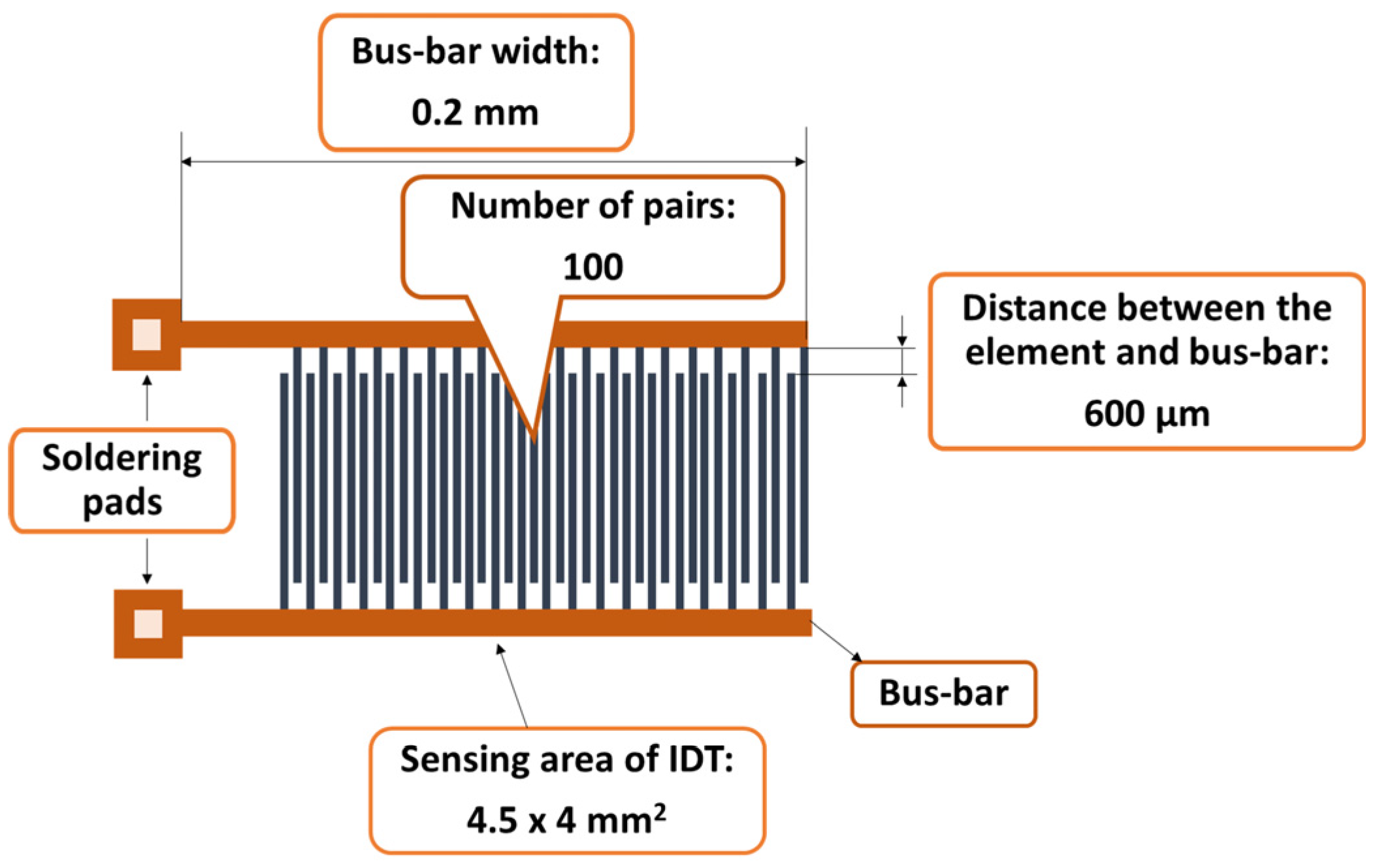


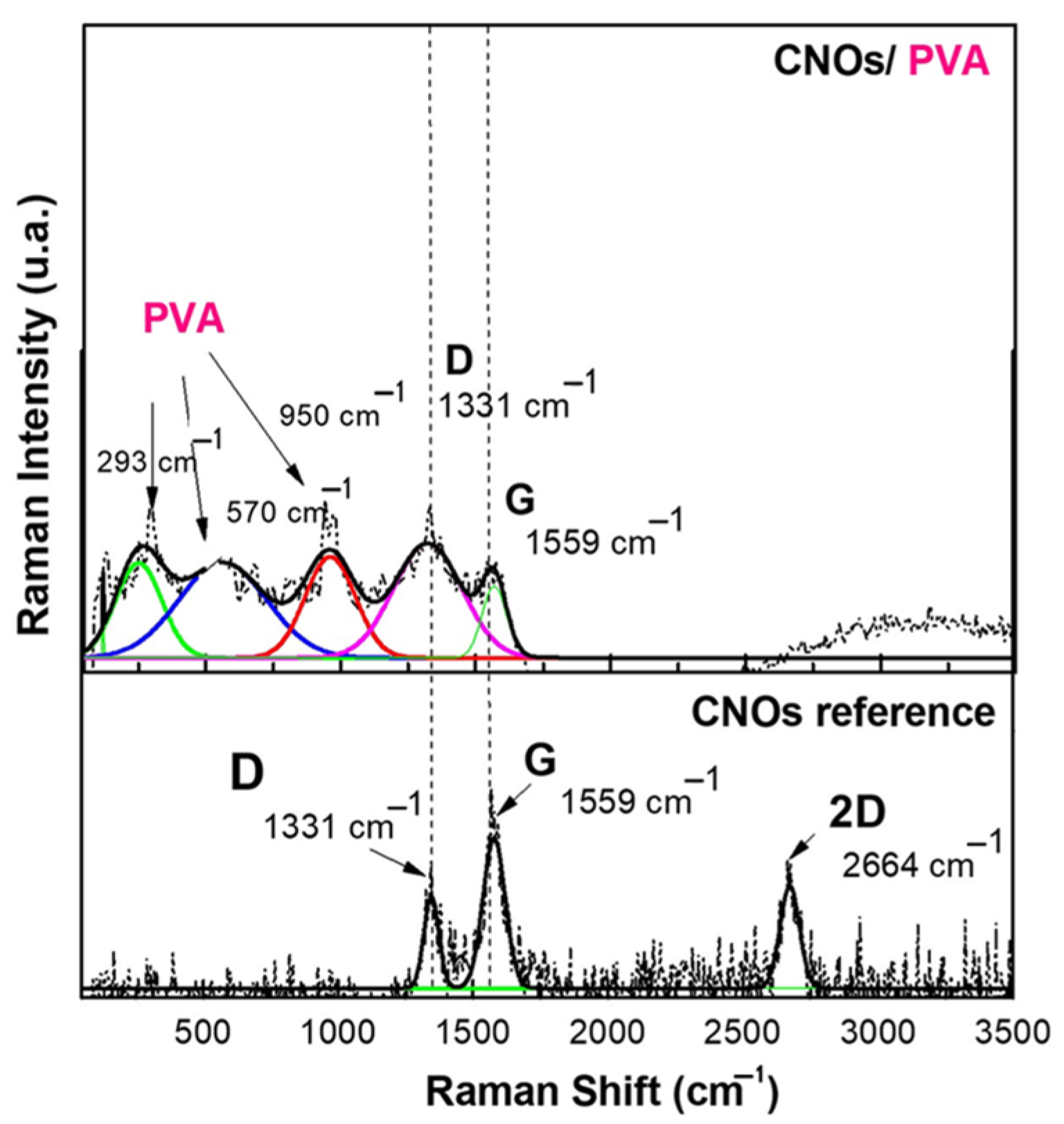
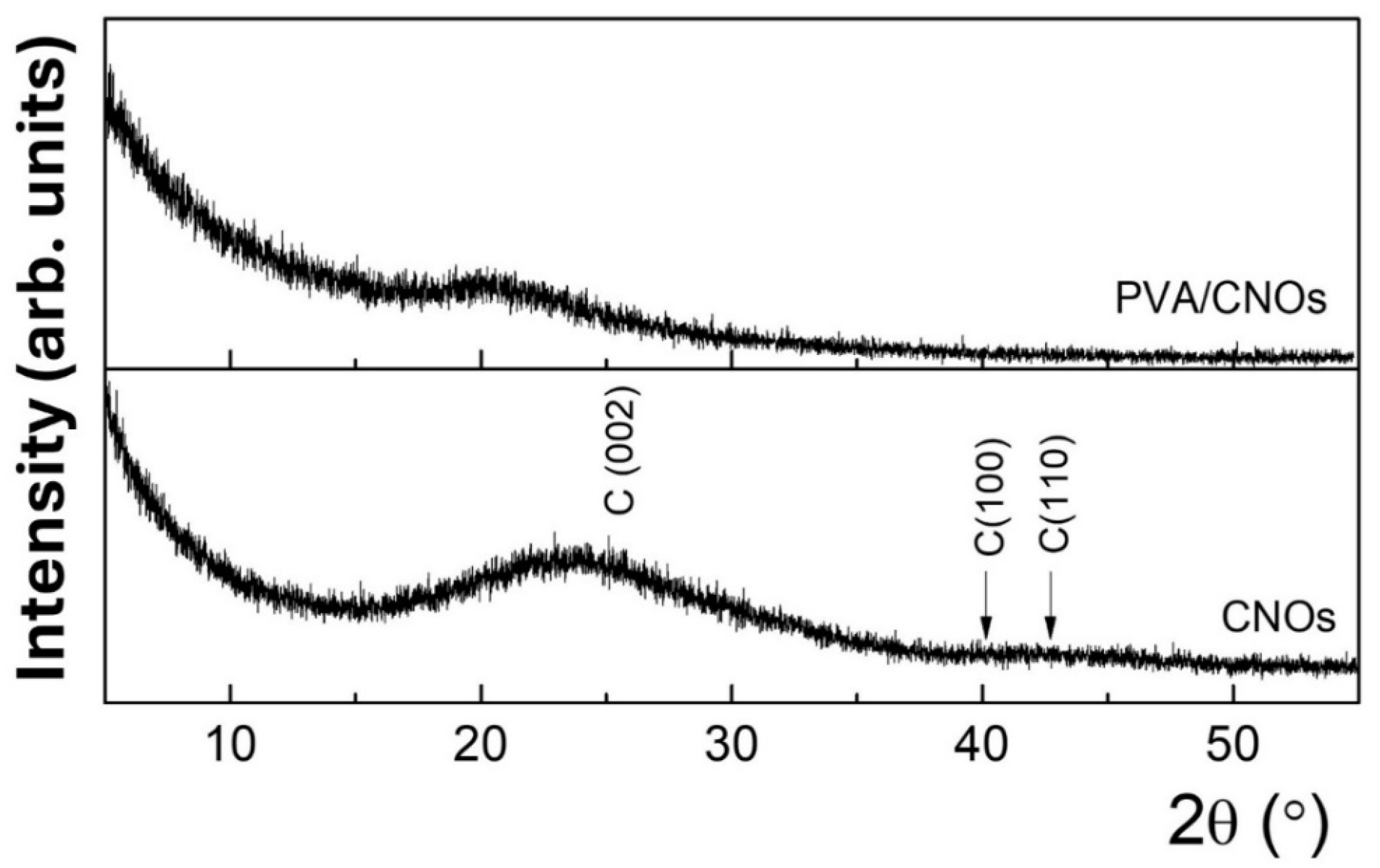

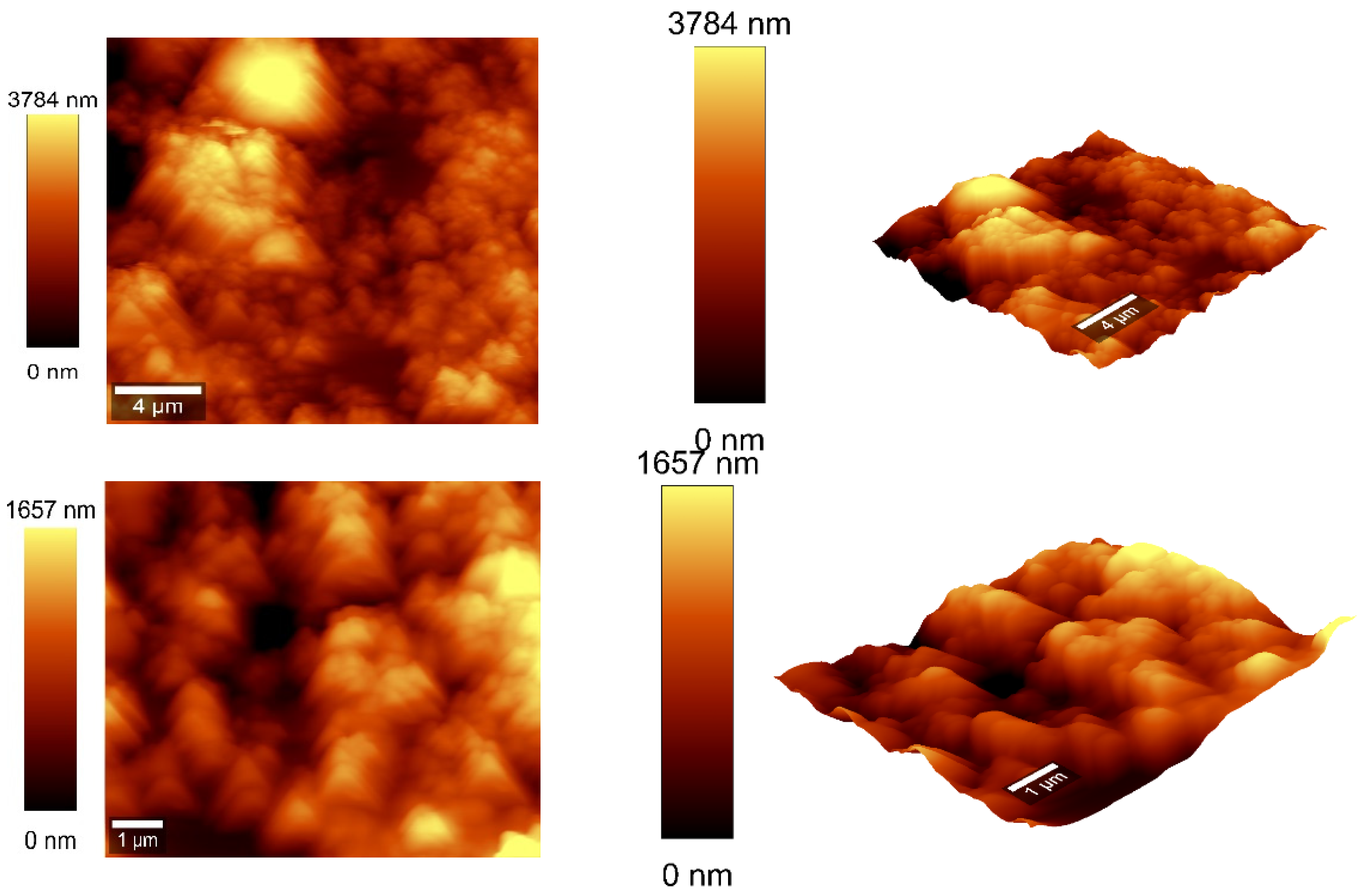

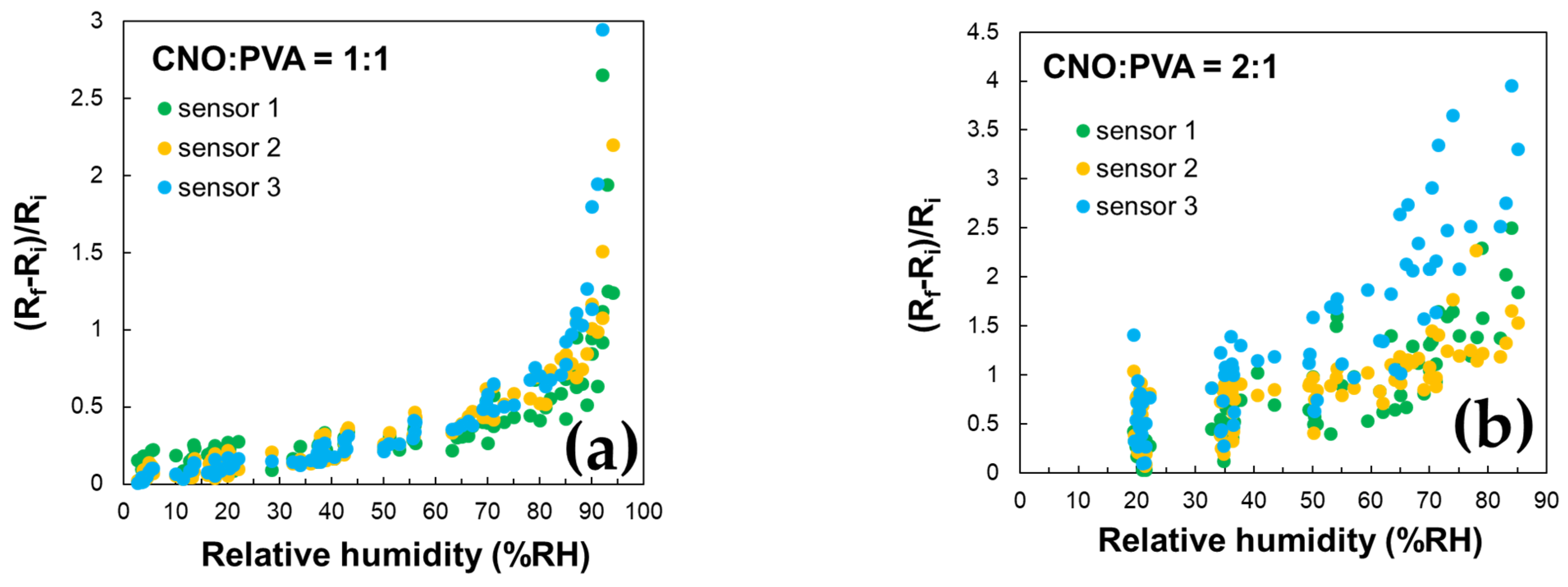

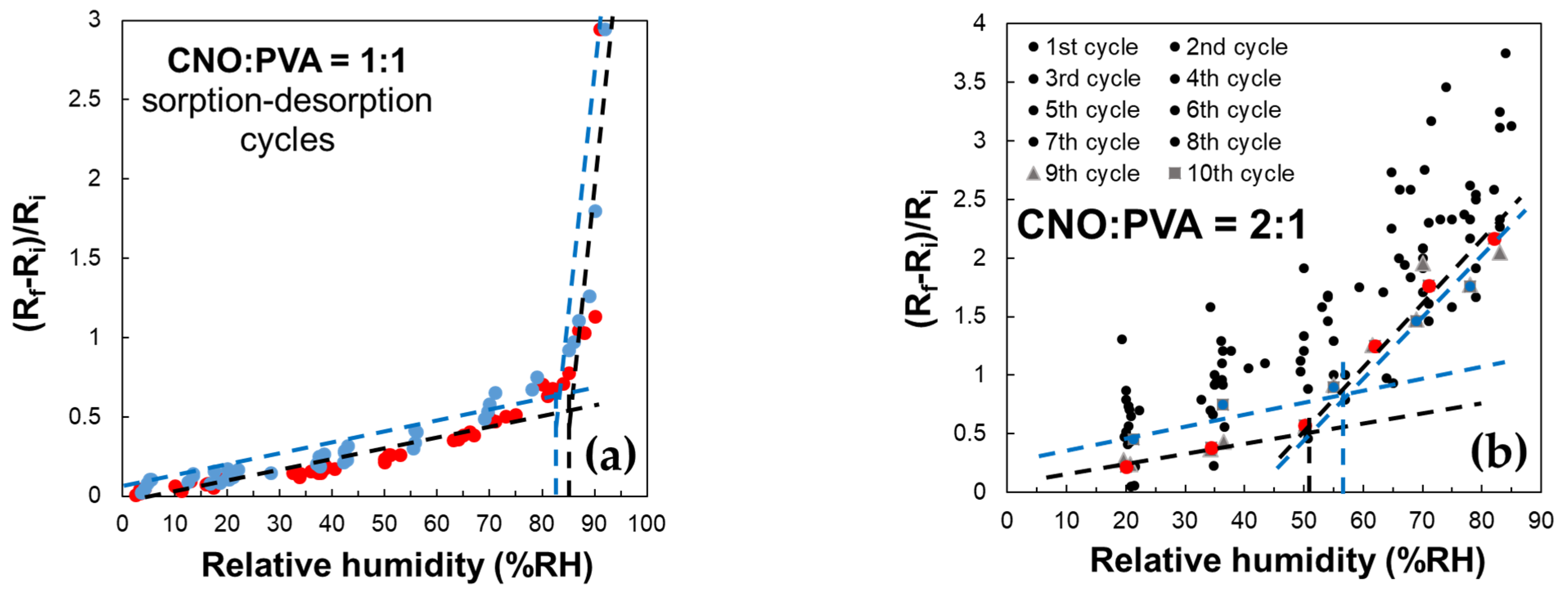
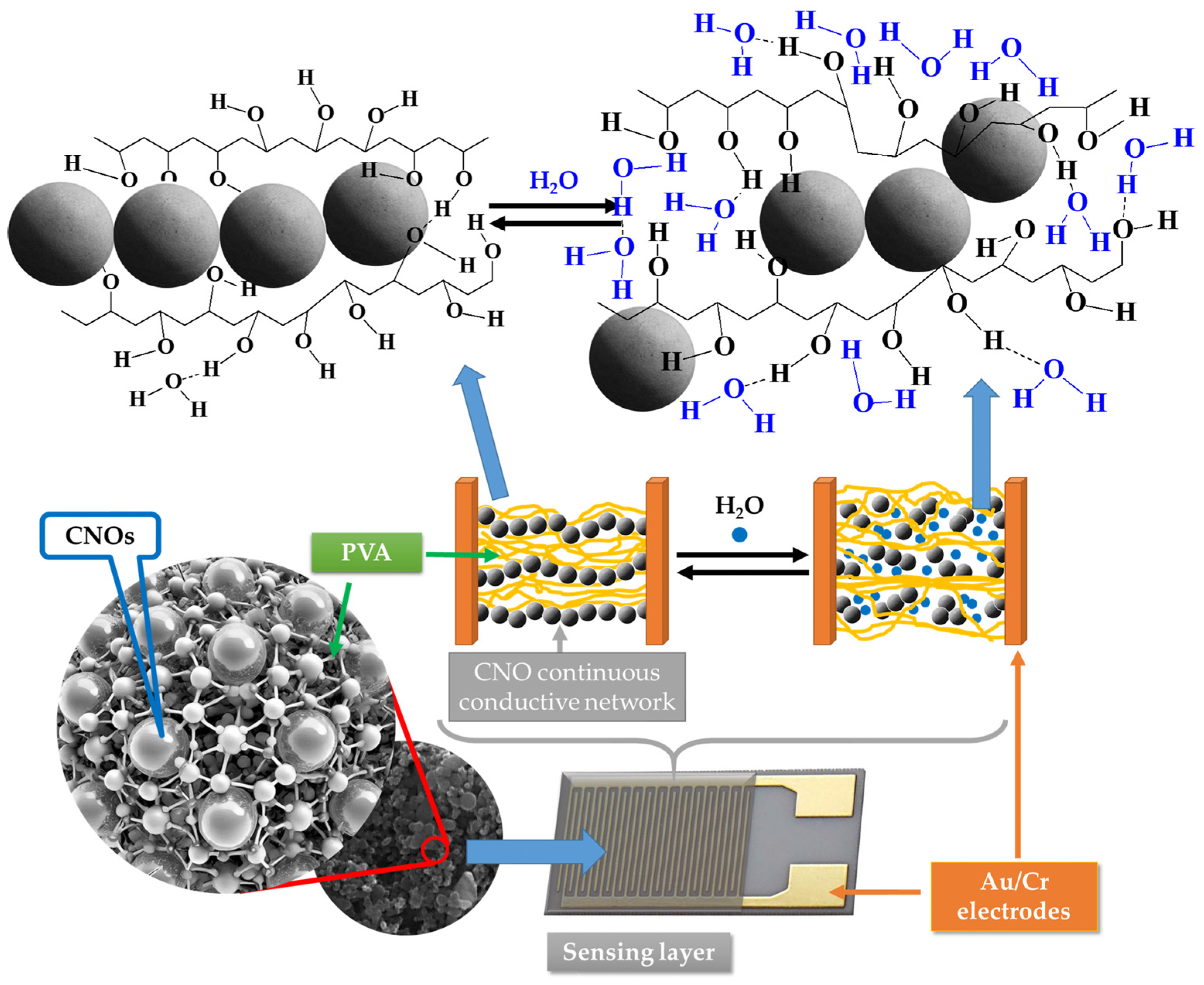
| Type of Nanocomposite/Nanohybrid | Type of Sensor | Reference |
|---|---|---|
| Sodium hyaluronate (SH)–multi-walled carbon nanotubes (MWCNTs) | Resistive | [44] |
| Nitrocellulose–MWCNTs | Resistive | [45] |
| NaCl/OH–MWCNTs | Electrochemical | [46] |
| PVA–graphene flower | Capacitive | [47] |
| PVP-reduced graphene oxide (RGO) | Resistive | [48] |
| Graphene oxide (GO)–PVA | Optical | [49] |
| Cellulose nanocrystals–GO | Capacitive | [50] |
| MWCNTs–polyimide | Resistive | [51] |
| Single-walled carbon nanotubes (SWCNTs)–PVA filaments | Resistive | [52] |
| Flexible cellulose–carbon nanotubes | Strain / Stress | [53] |
| PVP–carbon dots | Resistive | [54] |
| KCl/carbon black/halloysite nanotubes | Electrochemical | [55] |
| Nanodiamond–cellulose nanocrystals | Surface acoustic wave (SAW) | [56] |
| Flake-like nanodiamond–chitosan composite | SAW | [57] |
| GO–oxidized carbon nanohorns (CNHox)–PVP | Resistive | [58] |
| CNHox–PVP | Resistive | [59] |
| CNHox–PVA | Resistive | [59] |
Disclaimer/Publisher’s Note: The statements, opinions and data contained in all publications are solely those of the individual author(s) and contributor(s) and not of MDPI and/or the editor(s). MDPI and/or the editor(s) disclaim responsibility for any injury to people or property resulting from any ideas, methods, instructions or products referred to in the content. |
© 2025 by the authors. Licensee MDPI, Basel, Switzerland. This article is an open access article distributed under the terms and conditions of the Creative Commons Attribution (CC BY) license (https://creativecommons.org/licenses/by/4.0/).
Share and Cite
Serban, B.-C.; Dumbravescu, N.; Buiu, O.; Bumbac, M.; Dumbravescu, C.; Brezeanu, M.; Pachiu, C.; Nicolescu, C.-M.; Romanitan, C.; Brincoveanu, O. Carbon Nano-Onions–Polyvinyl Alcohol Nanocomposite for Resistive Monitoring of Relative Humidity. Sensors 2025, 25, 3047. https://doi.org/10.3390/s25103047
Serban B-C, Dumbravescu N, Buiu O, Bumbac M, Dumbravescu C, Brezeanu M, Pachiu C, Nicolescu C-M, Romanitan C, Brincoveanu O. Carbon Nano-Onions–Polyvinyl Alcohol Nanocomposite for Resistive Monitoring of Relative Humidity. Sensors. 2025; 25(10):3047. https://doi.org/10.3390/s25103047
Chicago/Turabian StyleSerban, Bogdan-Catalin, Niculae Dumbravescu, Octavian Buiu, Marius Bumbac, Carmen Dumbravescu, Mihai Brezeanu, Cristina Pachiu, Cristina-Mihaela Nicolescu, Cosmin Romanitan, and Oana Brincoveanu. 2025. "Carbon Nano-Onions–Polyvinyl Alcohol Nanocomposite for Resistive Monitoring of Relative Humidity" Sensors 25, no. 10: 3047. https://doi.org/10.3390/s25103047
APA StyleSerban, B.-C., Dumbravescu, N., Buiu, O., Bumbac, M., Dumbravescu, C., Brezeanu, M., Pachiu, C., Nicolescu, C.-M., Romanitan, C., & Brincoveanu, O. (2025). Carbon Nano-Onions–Polyvinyl Alcohol Nanocomposite for Resistive Monitoring of Relative Humidity. Sensors, 25(10), 3047. https://doi.org/10.3390/s25103047










